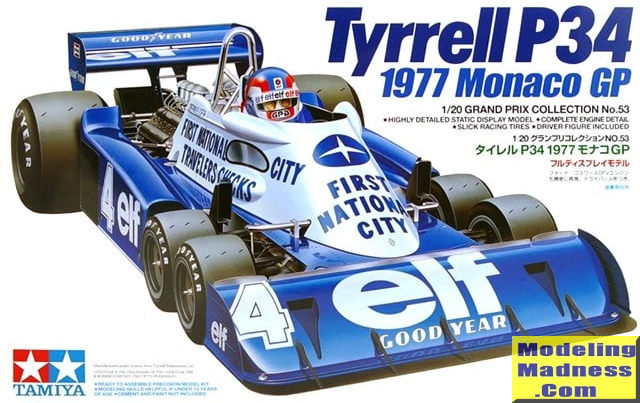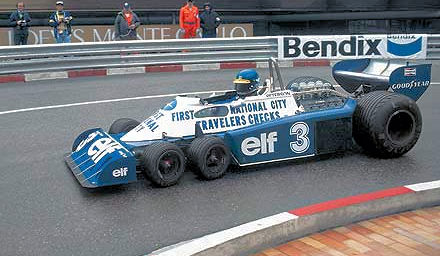
Tamiya 1/20 Tyrrell P 34 '1977 Monaco GP'
| KIT #: | 20053 |
| PRICE: | 2000 yen SRP |
| DECALS: | Two options |
| REVIEWER: | Scott Van Aken |
| NOTES: | Initially released in 2002 |

| HISTORY |
The Tyrrell P34 (Project 34), commonly known as the "six-wheeler", was a Formula One (F1) race car designed by Derek Gardner, Tyrrell's chief designer. The car used four specially manufactured 10-inch-diameter (254 mm) wheels and tyres at the front, with two ordinary-sized wheels at the back. Along with the Brabham BT46B "fancar" developed in 1978, the six-wheeled Tyrrell was one of the most radical entries ever to succeed in F1 competition, and has been called the most recognizable design in the history of world motorsports.
 The P34
was introduced in September 1974, and began racing in the 1976 season. It proved
successful, and led other teams to begin design of six-wheeled platforms of
their own. Changes to the design made for the 1977 season made it uncompetitive
and the concept was abandoned for Tyrrell's 1978 season. The other six-wheeled
designs ended development, and F1 rules later stipulated that cars must have
four wheels in total. The existing frames have since seen some success in
various "classics" race events, but today are museum pieces.
The P34
was introduced in September 1974, and began racing in the 1976 season. It proved
successful, and led other teams to begin design of six-wheeled platforms of
their own. Changes to the design made for the 1977 season made it uncompetitive
and the concept was abandoned for Tyrrell's 1978 season. The other six-wheeled
designs ended development, and F1 rules later stipulated that cars must have
four wheels in total. The existing frames have since seen some success in
various "classics" race events, but today are museum pieces.
The car's lone win was in the 1976 Swedish GP while driven by Jody Scheckter. This boxing is from the 1977 Monaco GP where both cars retired with mechanical issues.
| THE KIT |
Once all that is attached to the firewall on the back of the floor pan, the front suspension can be build up. With four front wheels you have twice the parts to deal with. Interestingly, the suspension and coolant radiators attach to the upper bodywork. On the flip side is the seat with instrument panel and wheels. The kit provides decals for the seat harness if you don't want to use the included driver figure.
 The last
steps are the addition of the engine injector stacks, the build up of the rear
wings and the attachment of the wheels/tires. The very upper part of the body,
which on this car is painted white, is designed to be removable if you so wish.
The last
steps are the addition of the engine injector stacks, the build up of the rear
wings and the attachment of the wheels/tires. The very upper part of the body,
which on this car is painted white, is designed to be removable if you so wish.
| CONCLUSIONS |
| REFERENCES |
https://en.wikipedia.org/wiki/Tyrrell_P34
July 2017
Copyright ModelingMadness.com. All rights reserved.
If you would like your product reviewed fairly and fairly quickly, please contact the editor or see other details in the Note to Contributors.
Back to the Main Page Back to the Review Index Page Back to the Previews Index Page